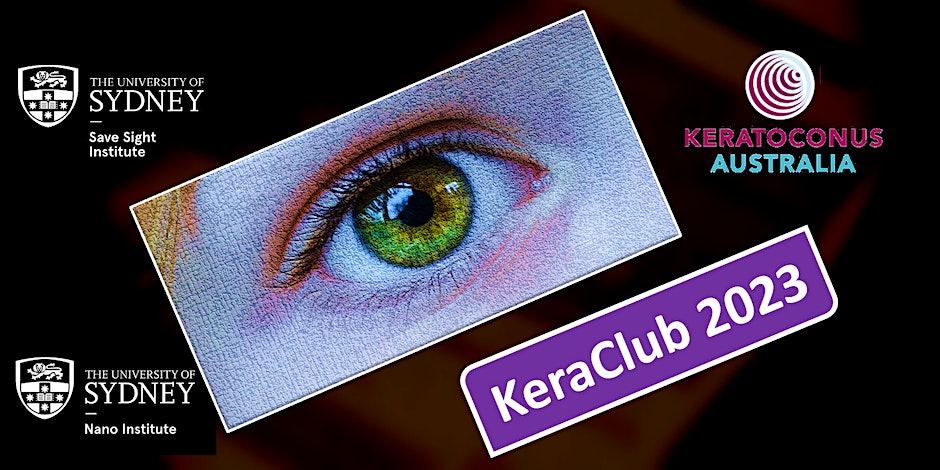
Happy World Keratoconus Day!
Today, November 10 is designated as the international day to raise awareness of keratoconus. On this day, patients, family members, and eyecare professionals are encouraged to educate others and to show support for those living with keratoconus.
Living with keratoconus is not always easy. So remember to take time to congratulate yourself and the people you know with keratoconus for getting through another year and celebrate the day. There are more options to improve your vision and eye health than ever before - next year will be even better!
Here are just some things you can do to become involved and to learn more about keratoconus and the new ways of managing this disease and avoiding its pitfalls.
Please post your photos, experiences and stories about keratoconus with the hashtag #worldkcday
KERACLUB 2023

KeraClub 2023 is an annual event held to bring together patients, their families and friends with leading researchers and clinicians to discuss their experiences and to hear about the latest research in the field of keratoconus.
This year's event focussed on mental health and the latest developments in stem cell research into treatments for keratoconus and other ocular disease. Save Sight Keratoconus Registry researchers discussed the results from new world-first studies into corneal collagen crosslinking. Attendees also heard all about contact lenses for keratoconus, which types are needed for the different stages of keratoconus and what is being done about the cost of these lenses.
Keratoconus Australia also explained why the changing keratoconus landscape requires a new approach to support and advocacy and how a younger generation of volunteers can help provide the services required today by people with keratoconus and their families.
A video of the event is now on our YouTube channel. Not to be missed!
KERATOCONUS PHOTO COMPETITION
You can also show others highlights from your life with keratoconus by joining the Keratoconus Photo Competition. Just submit your photos of how you enjoy life despite keratoconus on the International Keratoconus Photo competition page
Submissions must be received by November 10, 2023. No more than two photo submissions per entrant. Full details can be found here

REMEMBER
- Avoid eye rubbing allergies and itchy eyes are often associated with keratoconus. Eye rubbing can trigger or worsen keratoconus. Use allergy drops and cold compresses rather than fingers to ease itchy eyes
- 6-12 monthly reviews Keratoconus is a progressive disease and can advance quickly in adolescents and young adults. Schedule a review with your eye-carer (generally optometrist/contact lens fitter) every 6-12 months. Incorrectly-fitted contact lenses can cause irritation and scarring. Crosslinking may be required to halt further progression.
- Corneal crosslinking must be done early Corneal crosslinking is the only procedure that can slow of halt progression in keratoconus. But it cannot usually be performed safely on thin corneas. Don't miss the opportunity to have this sight saving operation. See your eye-carer as soon as you notice a change in your vision.
- Rinse lens with saline solution and wash your hands Tap water contains all sorts of nasty bacteria that cause serious eye infections. Don't take the risk: use saline solution to rinse your lenses after cleaning them in the evening and to rinse out your contact lens case every morning before drying with a tissue. And wash your hands before handling contact lenses!
- Emergency spectacles Everyone should have a pair of emergency spectacles if you wear contact lenses. They don't provide perfect vision. But they do enable you to do things around the house, make bathroom trips in the night and avoid wearing lenses in the dry atmosphere of a plane on long trips. Ask your keratoconus specialist optometrist about a pair
- Treatment and Travel Subsidies The cost of treatments for keratoconus is spiralling out of control. We have compiled a list of state-based funding schemes for vision related treatments and clinics where these can be found. For regional and remote patients, travel assistance schemes also exist to subsidise the cost of travel for treatment outside of your local area. Take advantage of these to get the best treatments
- Patience is a virtue... for both patient and eye-carer Keratoconus is often frustrating for both patient and their eye-carers. Fitting contact lenses can be very a lengthy and complex process and both parties need to be patient. 3-12 months of trial and error are not uncommon. Also, the right fit is not always possible and surgery does not always yield the desired result. Talk to your eye-carers before you start a treatment to understand risks and costs and what will happen if things don't work out as planned.
DONATE
We need your support.
Keratoconus Australia is operated entirely by volunteers and manages on a very small budget. The Association is fully funded from donations. It receives no government funding or corporate sponsorship.
We work to support people with keratoconus and their families and advocate on their behalf. We also contribute to important research into keratoconus being conducted in Australia, notably by the Save Sight Keratoconus Registry and the Centre for Eye Research Australia.
If you would like to support our Association and its important work, please donate now. You can also organize a fundraiser on our behalf here.

